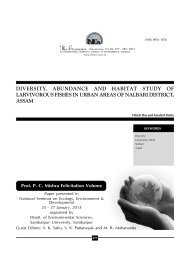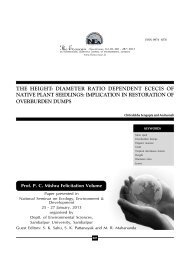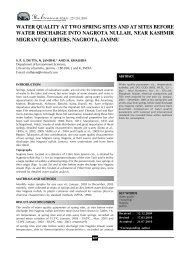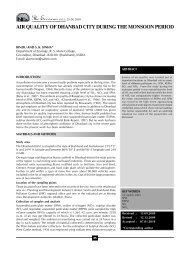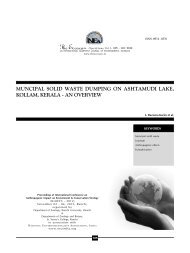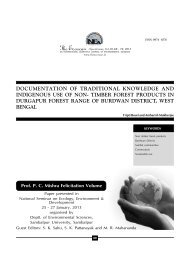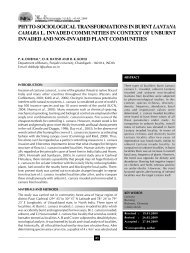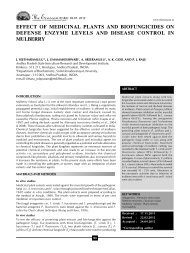Soma Chanda.pmd - An International Quarterly Journal of ...
Soma Chanda.pmd - An International Quarterly Journal of ...
Soma Chanda.pmd - An International Quarterly Journal of ...
You also want an ePaper? Increase the reach of your titles
YUMPU automatically turns print PDFs into web optimized ePapers that Google loves.
ISSN: 0974 - 0376<br />
NSave Nature to Survive<br />
: Special issue, Vol. III: 65 - 68; 2013<br />
AN INTERNATIONAL QUARTERLY JOURNAL OF ENVIRONMENTAL SCIENCES<br />
www.theecoscan.in<br />
STUDY OF SOME NON-TIMBER FOREST PRODUCTS (NTFPS)<br />
ASSOCIATED WITH THE LIVES OF TRIBALS IN MATHA<br />
FOREST REGION OF PURULIA DISTRICT, WEST BENGAL<br />
<strong>Soma</strong> <strong>Chanda</strong> and Ambarish Mukherjee<br />
KEYWORDS<br />
Non-Timber Forest Products<br />
Tribals<br />
Purulia<br />
Pr<strong>of</strong>. P. C. Mishra Felicitation Volume<br />
Paper presented in<br />
National Seminar on Ecology, Environment &<br />
Development<br />
25 - 27 January, 2013<br />
organised by<br />
Deptt. <strong>of</strong> Environmental Sciences,<br />
Sambalpur University, Sambalpur<br />
Guest Editors: S. K. Sahu, S. K. Pattanayak and M. R. Mahananda<br />
65
NSave Nature to Survive<br />
QUARTERLY<br />
SOMA CHANDA* AND AMBARISH MUKHERJEE<br />
Centre for Advanced Study, Department <strong>of</strong> Botany, University <strong>of</strong> Burdwan<br />
Burdwan - 713 104, West Bengal, INDIA<br />
E-mail: somac10@gmail.com<br />
ABSTRACT<br />
During the course <strong>of</strong> an ethnobotanical study<br />
undertaken in tropical dry deciduous forest in<br />
Matha <strong>of</strong> Purulia district, West Bengal, the<br />
authors recorded through an intimate contact<br />
with the different tribal communities <strong>of</strong> the<br />
area (viz. Santhal, Bhumij, Munda) their knowledge<br />
about the non-timber use <strong>of</strong> 35 species<br />
belonging to 27 families <strong>of</strong> which 28 are dicotyledonous,<br />
six monocotyledonous and one<br />
pteridophytic. A precise account has been prepared<br />
in this work <strong>of</strong> their habits, ethnic names,<br />
present status in the study site and use, an<br />
analysis <strong>of</strong> which shows11 different use categories.<br />
The knowledge <strong>of</strong> the tribes which<br />
traditionally concerns medicinal use <strong>of</strong> 20<br />
species is noteworthy. It is interesting to find<br />
three species linked with their religious and<br />
cultural activities. Sustainable use <strong>of</strong> these<br />
plants for conservation and economic benevolence<br />
<strong>of</strong> the indigenous communities are necessary.<br />
INTRODUCTION<br />
India is a country which is flourished with pr<strong>of</strong>ound forest resources. However the<br />
annual loss <strong>of</strong> Indian forests is presently about 1.5 million hectares (Ahmed, 2004)<br />
so that the existing forests cover is about 20% <strong>of</strong> the total geographical area <strong>of</strong> the<br />
country. Since this value needs to be elevated nearly to one third <strong>of</strong> the total<br />
geographical area, efforts are launched on war-footing for aforestation collaterally<br />
with restoration and conservation <strong>of</strong> the existing forests utilizing the self designing<br />
capacity <strong>of</strong> the nature. The non-timber forest products (NTFP), i.e. “<strong>An</strong>y commodity<br />
obtained from the forest that does not necessitate harvesting trees” (<strong>An</strong>on., 2008)<br />
have now started getting consideration in matters <strong>of</strong> conservation through their<br />
sustainable economic use. In view <strong>of</strong> the foregoing, the present work was<br />
undertaken in such an area as Matha a forest <strong>of</strong> Ayodhya hill which is rich in both<br />
density and diversity <strong>of</strong> tribal populations. The present work, new <strong>of</strong> its kind for the<br />
area, adheres to the objective <strong>of</strong> documenting from primary sources the indigenous<br />
knowledge about the use <strong>of</strong> forest plants associated with the lives <strong>of</strong> the hill tribes.<br />
This work is in conformity with the earlier work <strong>of</strong> the present author on the Sikari<br />
tribe settled in Ayodhya Hills (<strong>Chanda</strong>, 2010).<br />
Study Site<br />
Purulia, lying between 22º60’ and 23º50’ north latitude and 85º75’ and 86º65’<br />
east longitude, is one <strong>of</strong> the draught prone and economically backward districts <strong>of</strong><br />
West Bengal. The district occupies an area <strong>of</strong> 6259 sq km with forests covering<br />
nearly 87.60 thousand hectares and ranks second in West Bengal so far tribal<br />
diversity and density are concerned. The present work was undertaken in Matha<br />
forest <strong>of</strong> Ayodhya hill, which is a tribal dominated area. The climate <strong>of</strong> the area is <strong>of</strong><br />
tropical monsoon type with three seasons, viz. pre-monsoon (mid-February to<br />
mid-June), monsoon (mid-June to mid-October) and post-monsoon (mid-October<br />
to mid-February).The soil is <strong>of</strong> lateritic type and the temperature ranges from 26ºC<br />
to 44ºC during summer and from 11ºC to 24ºC during winter. <strong>An</strong>nual rainfall is<br />
more or less 1033mm and .relative humidity is highest during July to September.<br />
MATERIALS AND METHODS<br />
*Corresponding author<br />
Field work was performed during 2010 and 2011 in Matha forest range to document<br />
the primary data concerning the plants species used as sources <strong>of</strong> food, fuel,<br />
forage, medicine and drugs, dyes, fibers and other essentials as classified under<br />
non timber forest produce (NTFP) by Neggi (2002). The primary data were based<br />
on the knowledge and experience gained from knowledgeable informants, middleaged<br />
women and medicine men <strong>of</strong> different tribal community following standard<br />
ethnobotanical methods (Rao, 1989). Pertinent plant specimens were collected<br />
adequately some <strong>of</strong> which were taxonomically worked out to identify them using<br />
relevant literature (Prain 1903; Guha-Bakshi 1984; Bennet 1987; Panigrahi and<br />
Murti, 1989; Murti and Panigrahi, 1999) and the rest were processed for herbarium<br />
preservation as voucher specimens following Jain and Rao (1977).<br />
66
NON PRODUCTS T TRIBALS IN MATHA FOREST<br />
Table 1: Plants recognized as Non-timber Forest Produce during ethnobotanical studies in Matha forest region <strong>of</strong> Purulia district, West Bengal<br />
Plant species Family Vernacular Name Habit Present status Use category<br />
Buchanania lanzan <strong>An</strong>acardiaceae Piyal Tree Very Common M, WE, Fo<br />
Butea monosperma Fabaceae Palash Tree Very common M, Be, R and C, Dy, Fu<br />
Calotropis gigantea Asclepiadaceae Dhutra Shrub Less common M<br />
Careya arborea Lecythidaceae Kumbhi/ Astha Tree Common M<br />
Dioscorea alata Dioscoreaceae Chupri alu Climber Common WE, M<br />
Diospyros melanoxylon Ebenaceae Kend Shrub Very common Be<br />
Dolichos biflorus Fabaceae Kurti kolai Climber Common M, We<br />
Helicteris isora Sterculiaceae Gamochra Shrub Less Common M, Fu<br />
Lagerstroemia parviflora Lythraceae Sidha Tree Common WM, Fu<br />
Sida cordata Malvaceae Berela Herb common M<br />
<strong>An</strong>drographis paniculata Acanthaceae Kalmegh Herb Common M<br />
Asparagus racemosus Liliaceae Satmul Climber Very common M, Be<br />
Bauhinia vahlii Caesalpiniaceae Chihor Climber Less common Ro, Gh, Fu, PL<br />
Boswellia serrata Burseraceae Salai Shrub Rare M<br />
Cassia fistula Caesalpiniaceae Banar pichal Tree Less common M<br />
Costus speciosus Costaceae Geo Herb Common M<br />
Dendrocalamus strictus Poaceae Bans Tree Very common M, WE<br />
Dillenia pentagyna Dilleniaceae Chalta Tree Common WE<br />
Holarrhena antidysenterica Apocynaceae Kurchi Shrub Very common M, Fu, Tha<br />
Indig<strong>of</strong>era tinctoria Fabaceae Nil Herb Less common DY<br />
Lygodium flexuosum Schizaeaceae Durga japhi,Kalijar Herb Less common M, WE<br />
Madhuca indica Sapotaceae Madkom Tree Very common Be, M, R and C, Fu.<br />
Melia azedarach Meliaceae Mahanim Tree Less common M, Ins<br />
Phoenix acaulis Palmae Bhui khejur Shrub Common WE<br />
Pterocarpus marsupium Leguminosae Piyasal Tree Common PW<br />
Semicarpas anacardium <strong>An</strong>acardiaceae Vela Shrub Common WE<br />
Shorea robusta Dipterocarpaceae Sal Tree Very Common M, R andC,<br />
Smilax macrophylla Smilacaceae Ramdatun Climber Very common M<br />
Symplocos racemosa Symplocaceae Loth Tree Less common M<br />
Syzygium cumini Myrtaceae Jam Tree Very common M, WE<br />
Terminalia chebula Combretaceae Hartaki Tree Less common M<br />
Tylophora indica Asclepiadaceae <strong>An</strong>tamul Climber Very common M<br />
Urginia indica Liliaceae Bonpiyaj Herb Common M, Ins<br />
Woodfordia fruticosa Lythraceae Dhatki Shrub Common M, WE, Fu<br />
Ziziphus mauritiana Rhamnaceae Kul Tree Common WE, M<br />
M= Medicinal, WE= Wild edible, Dy=Dye yielding, Be= Beverage, Oy= Oil yielding, Fu= Fuel wood, Ins= Insecticidal use, PL= Plates from leaves, R and C= Religious and cultural<br />
activities, Wm= Wood for minor purposes without felling/harvesting <strong>of</strong> trees, Pw= Pole wood, F= Forage, Ro=Rope making, Pl= Plate making<br />
RESULTS AND DISCUSSION<br />
A taxonomic analysis <strong>of</strong> the phytoresources, thus scored<br />
(Table1), shows concern <strong>of</strong> 34 species <strong>of</strong> 27 families from<br />
Magnoliophyta (angiosperm) and one from Pteridophyta, with<br />
the life and livelihood <strong>of</strong> the tribal communities <strong>of</strong> Matha<br />
area. The dicotyledonous plants are more used than monocots.<br />
The ratio <strong>of</strong> tree, shrub, herb and climber species used<br />
by them was found to be 15:8:6:6 which is somewhat at par<br />
with the physiognomy <strong>of</strong> the forests with which they are in<br />
traditional bondage. The indigenous knowledge thus recorded,<br />
especially about the medicinal use <strong>of</strong> 27 species,<br />
deserves great appreciation since no less than14 use categories<br />
could be analyzed. To strengthen programmes <strong>of</strong> conservation<br />
<strong>of</strong> the concerned phytodiversity there is a need to convey<br />
economic benevolence to the indigenous people through<br />
their sustainable use. Leaves and tender shoots <strong>of</strong> three species<br />
are used to feed the domestic animals. For making beverage<br />
four species are used. As many as 11 wild edible species<br />
have also been documented. The proximate principles <strong>of</strong> wild<br />
edibles, documented in this work, need scientific evaluation,<br />
to address issues <strong>of</strong> food security <strong>of</strong> the tribals and cater our<br />
nutritional requirements. Perpetuation <strong>of</strong> religious and cultural<br />
activities <strong>of</strong> the tribals linked with the indigenous<br />
phytoresources is also deemed essential for ensuring long term<br />
sustainability <strong>of</strong> the noosystem in concern.<br />
REFERENCES<br />
Ahmed, M. 2004. Deforestation effects on species diversity index <strong>of</strong><br />
terrestrial vegetation <strong>of</strong> Goalpara (Assam) and East Garo Hills District<br />
(Meghalaya), India. Plant Archives. 4: 53-60.<br />
Bennet, S. S. R. 1987. Name changes in flowering plants <strong>of</strong> India and<br />
adjacent regions. Triseas Publishers, Dehradun,.<br />
<strong>Chanda</strong>, S. 2010. Plants in ‘Sikari’ medicine from Ajodhya hills, Purulia<br />
district, West Bengal; Envis Newsletter, BSI, Kolkata. 15: 2.<br />
Guha Bakshi, D. N. 1984. Flora <strong>of</strong> Murshidabad District West Bengal,<br />
India. Scientific publishers, Jodhpur, India.<br />
Jain, S. K. and Rao, R. R. 1977. A Handbook <strong>of</strong> Field and Herbarium<br />
Methods. Today and Tomorrow’s Printers and Publishers, New Delhi.<br />
Murti, S. K. and Panigrahi, G. 1999. Flora <strong>of</strong> Bilaspur District, M.P.,<br />
Botanical Survey <strong>of</strong> India, Calcutta. 2: 397-906.<br />
Neggi, S. S. 2002. Forest Products and Their Utilization, <strong>International</strong><br />
Book Distributors, Dehradun.<br />
Panigrahi, G. and Murti, S. K. 1989. Flora <strong>of</strong> Bilaspur District, M. P.,<br />
Botanical Survey <strong>of</strong> India, Calcutta 1:1-396.<br />
Prain, D 1903. Bengal Plants, Calcutta, West Bengal.<br />
67
SOMA CHANDA AND AMBARISH MUKHERJEE<br />
Rao, R. R. 1989. Methods and techniques in ethnobotanical study<br />
and research: some basic consideration. In: Methods and Approaches<br />
in Ethnobotany (Ed. S. K. Jain) Society <strong>of</strong> Ethnobotanists, Lucknow.<br />
pp.13-23.<br />
68





